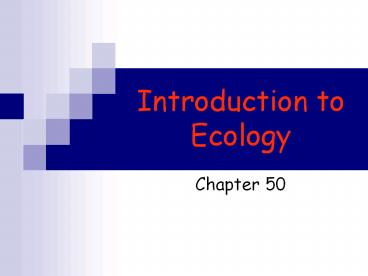Introduction to Ecology - PowerPoint PPT Presentation
1 / 30
Title: Introduction to Ecology
1
Introduction to Ecology
- Chapter 50
2
Ecology
- Study of interactions between organisms and the
environment - Interactions ?determine the abundance and
distribution of organisms - Since prehistoric times humans are interested in
this dist. abund.? WHY???
3
Ecology
- Changing? was a descriptive science, now is
becoming more of an experimental science - Provides a scientific context for evaluation of
environmental issues - Is very closely related to evolutionary biology
4
Environment
- Affects the distribution of organisms
- Is made up of
- Abiotic? no living components
- Biotic? living components
5
Abiotic Factors
- Light
- Water
- Temperature
- Soil
- O2/CO2
- Periodic disturbances in all these leads to
species diversity
6
Biotic Factors
- Individual organisms
- Populations
- Communities
- Ecosystems
- Biosphere? global ecosystem
- All living organisms of the earth ?portion that
can sustain life
7
Distribution of Organisms
- Distinct global and regional patterns in the
distribution of organisms - Biogeography is the study of past and present
distributions of individual species - Ecologists? what limits the geographical
distribution of any species
8
Factors that Affect Distribution
- Species dispersal
- Behavior and Habitat Selection
- Biotic factors
- Abiotic
9
(No Transcript)
10
Species dispersal
- Transplanted species
- Successful ?potential range of the species is
larger than the actual range. - Unsuccessful, ?distribution is limited by other
species or abiotic factors
11
Problems with Introduced Species
- Transplanted species? explode
- Ex African honeybee Zebramussel
12
Behavior and Habitat Selection
- organisms select particular habitats
- Insects ? oviposition, breeding areas
- Chemical signaling between plants and pollinators
- Evolution does not produce the perfect organism?
populations do not evolve overnight, even natural
selection may not be
13
Biotic Factors
- Predators limit distribution of prey species
14
Abiotic Factors
- Temperature
- Water
- Sunlight
- Wind
- Rocks and soil
15
Temperature and Water
- Climate is the prevailing weather conditions in
an area - major components? Temperature, water, light, and
wind - Climate determines the makeup of Biomes
16
Climate and Biomes
17
Temperature and Water
- Global Climate Patterns ?Sunlight Planets
movement
18
Temperature and Water contd
- Local and seasonal effects on climate
- Microclimate
- Long-term climate change
- Effect of mountains on rainfall
19
Biomes
- A distinct ecological community of plants and
animals living together in a particular climate - Biomes often run into each other
- Major types
- Aquatic
- Terrestrial
20
Aquatic Biomes
- Vertical stratification of aquatic biomes
- The photic zone
- The aphotic zone
- Thermocline
- The benthic zone
21
Freshwater biomes
- The littoral zone is shallow and close to shore.
- The limnetic zone is the open surface water.
- The profundal zone consists of the deep, aphotic
regions.
22
Lakes
- Oligotrophic
23
Lakes
- Eutrophic
24
Streams and Rivers
25
Wetlands
26
Estuaries
27
Zones in Marine Communities
28
Coral Reefs
29
Terrestrial Biomes
- Tropical Rain forest
- Savanna
- Desert
- Chaparal
- Temperate grasslands
- Temperate deciduous forest
- Coniferous forest
- Tundra
30
The Spatial Scale of Distributions
- Different factors may determine the distribution
of a species on different scales - Most species have small geographic ranges































